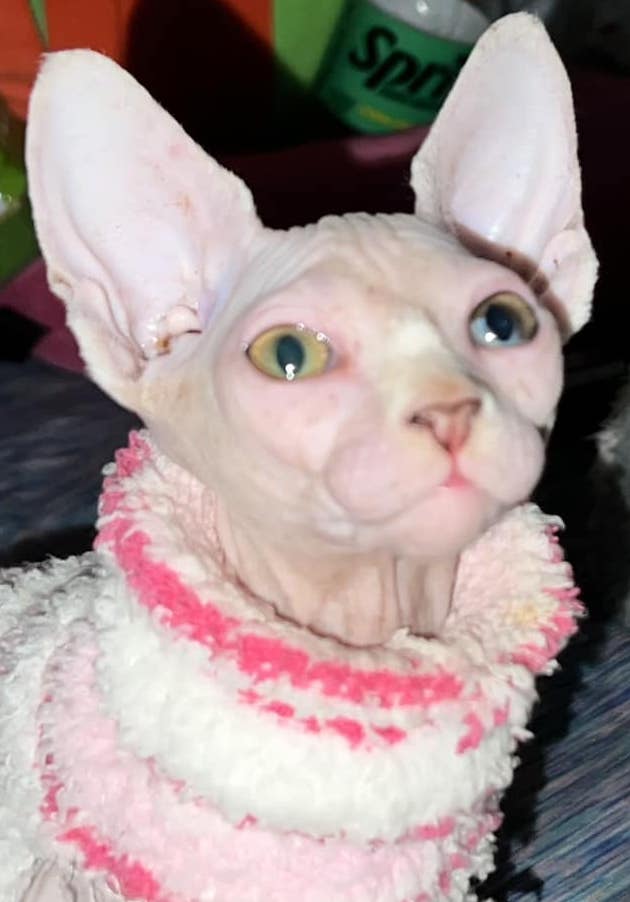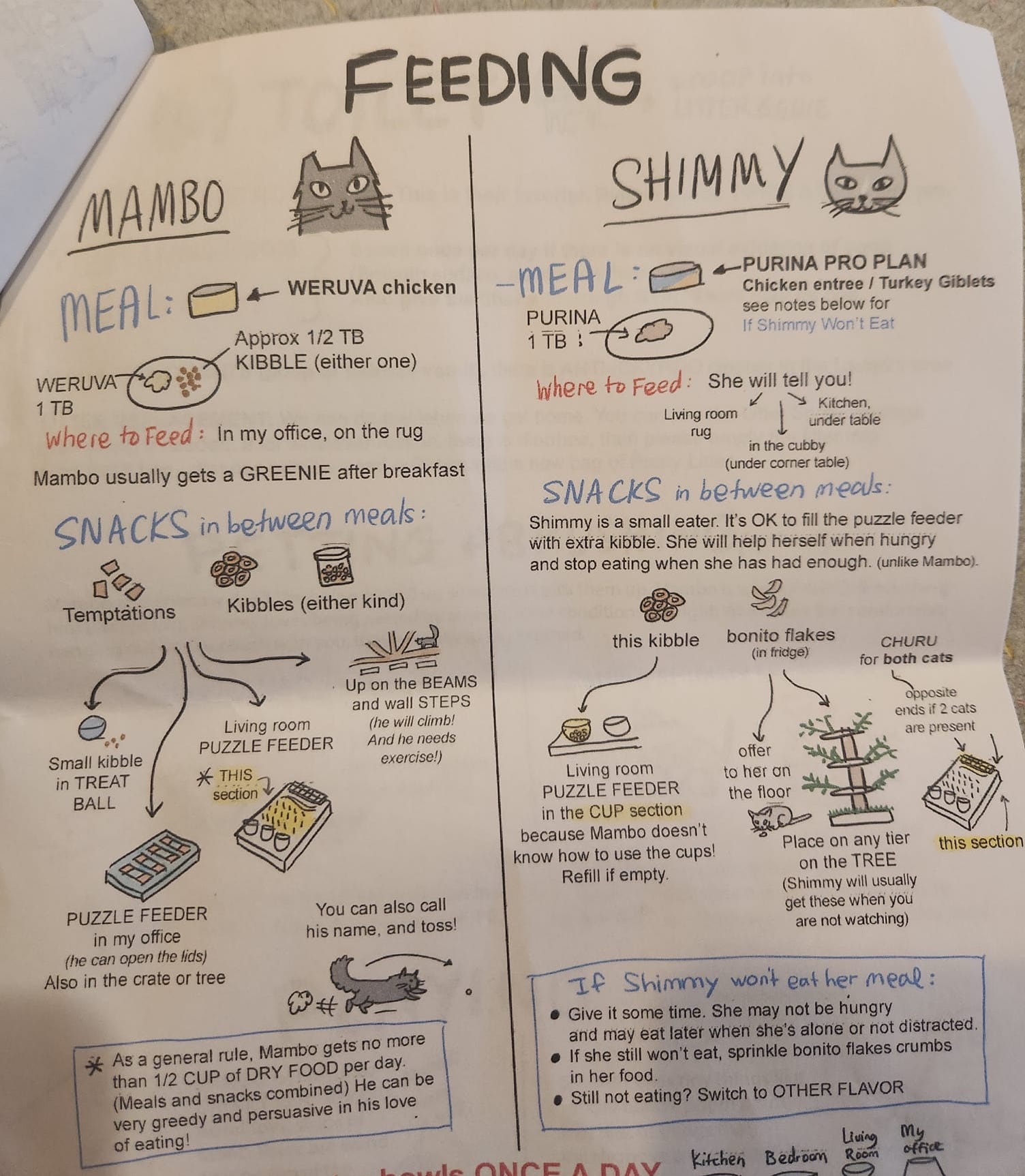Last week, I asked friends online, “What do you feed your dog?” Their answers were surprisingly full of important information!
This week, I asked instead, “What do you feed your cat?”
Here are their answers to that question and about these details:
> What do you feed your cat (for meals)?
> Brand name/s, specific product/s that you feed; raw or … ?
> How/why did you decide to choose this food?
> How do you feed—bowl, free feeder, timed feeder, or … ?
> How/why did you decide to feed by this method?
Ann Jorgensen (Alaska) Sphynx kitty Trillium is fed raw. Sphynxes have a high metabolism and are known for impressive and odious bathroom habits. Raw greatly reduces volume and odor. I use what is termed an 80/20 grind, with the BARF diet for reference. I typically use whole chicken-leg quarters for the 80% and a mixture of organ meats for the 20% (calf liver 10%, chicken gizzards and hearts 10%, and sometimes green tripe). High-nutrient organs should usually be kept at 10%. I add salt and in some cases extra supplements like taurine. Then I freeze in single-use containers. When I reconstitute, I add a good amount of water until it is the consistency of thin soup. I’ll often add a probiotic shot at this time. Trillium has access to greens and treats like Churu.
My rescue kitty Fuzzbucket is set in her/their ways. (She is the hermaphrodite/chimera.) She loves kibble, but is a bit picky. Not interested in the expensive brands, but I think she would love cat chow or Friskies (I call these McDonald’s for cats), so we came to an agreement on Purina One salmon, free fed. I just purchased an auto feeder—I’ve used these in the past and love them. (I had a 20-year-old Persian I had to ensure had regular access to food because of her age.) The new feeder also has Bluetooth, so I’m excited to play with this. I should add I have cameras in the home to watch the critters. Fuzzbucket is a huge fan of Churu sticks fish flavors and fish flakes. Fuzzbucket has come a long way from slated-for-euthanasia the day I adopted her/them, to loving on visitors. We found out she specifically loves men with beards.
There’s also a feeder that is activated by a microchip, so if you have a kitty on a special diet, you can ensure that only they eat their scripted diet. I have used these in the past with great success—the tech actually came from farming pigs. Lastly, in addition to food, I always use drinking fountains and filtered water. I love the ceramic pagoda from Petsafe.

Photo by Ann Jorgensen
Don Hanson (Maine) We feed a variety of commercial frozen raw diets to Boomer, rotating brands and proteins.
Gwen Jones (California) Raw food 2x day plus a small amount of canned food for medicine. The raw food comes from a local producer, Feed This, Inc. Occasional kibble is Orijen but I’m really trying to get her all on raw. She’s a finicky eater, so we haven’t been successful with that (yet!). She gets fed twice a day, out of plastic or ceramic dishes—metal was causing an allergic reaction. Decided to try her on raw after good success with dogs. Her coat is great, energy levels good, stools are smaller and less frequent than on kibble. I know where the food is processed and it’s not a big factory with heat, so nutrients are more bio-available to her. It was more difficult to feed this way with two cats—the other one was always stealing her food!
Erin Darling Looney (Washington) One cat eats Iams Kitten food; she is not a kitten, but it’s the only food she likes. Three cats eat Purina Protein because it keeps them full and they don’t just snack on it all day long. These three are a little chunky, so we try to watch what they eat. One cat eats Friskies wet food because she throws up everything else and has a hard time eating hard food. Friskies tuna, salmon, or chicken are the only things that don’t make her sick. They all get fed twice a day. That’s just the schedule I’ve always used for cats, so I’m not sure why we do it that way, but the cats are happy with it.
Karen Schlosberg (Massachusetts) Roo has some food sensitivities, so I have to feed her hydrolyzed protein and she gets the Purina Sensitive Stomach wet food. Three-quarters of a can twice a day because she is keeping her weight down. She gets single-item treats as well. She’s doing very well on this diet.
Ingrid Bock (New York) I feed my 18/19-year-old almost exclusively Fancy Feast, pâté-type because a cat vet told me that the pâtés have the most water, and the ‘land animal’ flavors because she also advised that. Every once in a while I switch it up and serve the fish flavors. Every once in a great while I give him a few Greenies cat treats to crunch on. I often/usually put a little water into the dish with his Fancy Feast, because he’s not a big drinker. I regularly offer him some of what the dogs are having in their topper ‘stew,’ and he loves beef, chicken, and turkey. About once per month, both cats get tuna. My 5/6-year-old cat eats Fancy Feast also, but because he eats a lot more, to switch up his flavors I sometimes give him Friskies, which comes in bigger cans. And I give him a little bit more dry (e.g., Greenies treats) to crunch on, since he’s young and likes to drink water. He won’t touch the ‘human food’ I serve the dogs and which the older cat loves. Both cats eat in bowls, but the older cat prefers to eat human food from my fingers. I tried switching the cats to a higher-quality wet food, but they weren’t having it and I gave up. I was told by that same cat vet that even the worst wet food is still better than the best kibble, so I switched to almost exclusively wet. That’s the most important message I try to tell people.
Sandee Strobel Szabo (Virginia) We have two formerly feral cats, now aged 14. We free-feed Wellness Complete Health Natural Grain-Free Salmon & Herring Dry Cat Food and Purina Pro Plan Adult Salmon & Rice Formula Dry Cat Food plus Friskies and 9 Lives wet food, a variety. They get their dry food one variety at a time until that bag is finished, then they get the second type of dry food. They also split a can of one of the wet foods between the two of them. We decided to do a mixture of grain-free and non-grain–free foods. We added in the wet food about three years ago. We did this to be sure that they keep hydrated and because it’s a little easier on their teeth.
Lili Chin (California)
> MAMBO: Weruva Paw Lickin’ Chicken
> SHIMMY: Purina Pro Plan Chicken Entree
We chose these foods after trying out many brands and flavors (they are picky kitties) and fortunately we finally found ones they each liked that the other cat doesn’t, so there is no stealing. They both eat the same Royal Canin digestive kibble.
(The printout is slightly out of date.)

Photo by Lili Chin
Em E Wolf (Vermont) Mostly higher-end wet food. Dry food is terrible for cats. I buy Tiki Cat, Orijen, and Instinct cans. Cats love variety. Mine love pâté by far over shredded. I dream of feeding raw, but haven’t made the switch yet. Cats are obligate carnivores, so check what you’re feeding them—make sure it’s meat, organs, etc., not peas and corn.
Isabel Alvarez Arata (Texas) I feed Weruva and Green Juju’s beef recipe. We opt for Weruva’s canned pâté and top it off with Green Juju’s beef freeze-dried recipe pet food. I chose both brands because I like their standards and commitment to pets.
Glenda Lee (Maine) Farrah gets Blue Buffalo kibble—typically a fish protein, but I do rotate her proteins. She’s free-fed, but always gets a bit of the dogs’ home-cooked at dinner and a spoonful of either tuna or salmon.
Rebecca Cook (Washington) My Roscoe, with all his health issues, has to be on a hypoallergenic food, so both cats eat prescription Hills Science Diet Z/D because I have found it impossible to feed them separately. They get both dry kibble to free-feed during the day. I’ve had bad luck with food aggression in a cat when they didn’t free-feed, and occasional weight issues if I didn’t make sure the kibble was healthy.
They share half a can of wet pâté each night. I put it in a dish with about a half cup of water and mash it up so it’s really wet. I started doing this when my older cat, Nahla, wasn’t getting enough water. They have a water fountain, but sometimes in the winter, she just isn’t motivated to drink much. We haven’t had any extra dry poo (my sign they need more water) since I started doing this. Unfortunately, hypoallergenic cat treats haven’t been made in almost a year, so we can’t do treats any more, but honestly, we don’t really need them.
Jett Wyatt (Arizona) Daily, the cats get a quarter-can each Lotus or Weruva cat food. The rest of their food is kibble; usually Pure Vita, NutriSource, Open Farm, or Farmina. They are a bit picky, so won’t eat anything with fish in it—although, for some reason, they are happy to eat MY tuna! I used to feed them twice a day, but they’d leave food behind. Now they are being fed once a day (same amount as before) and they finish it all.
For new cat guardians, don’t be surprised if you go through a lot of foods your cats won’t eat, or just pick at. Even the same protein—they’ll eat one canned chicken and turn up their nose at a different brand. They tend to be pretty choosy. It really does help to have a dog that will take care of leftovers!



